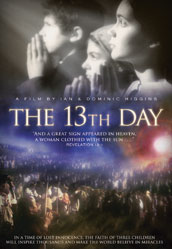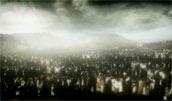An Event that Changed the World
The 13th Day Is the Finest Retelling of the Fatima Miracle
by Steven D. Greydanus
The 13th Day is the best movie ever made about Fatima — the most beautiful and effective, as well as one of the most historically accurate. Distilled to the bare essence of the events, mediated through evocative visuals and mood rather than character-based drama, The 13th Day has a clarity and intensity of a defining event in childhood that we rehearse in our minds for the rest of our lives.
That is, indeed, how The 13th Day approaches the apparitions at Fatima in 1917, through the eyes of 30-year-old Sister Lucia de Jesus Rosa Santos, living in seclusion at the Carmelite convent in Spain, writing the second of her six memoirs.
From the gathering darkness of the times — the first World War, the Bolshevik revolution, the fall of the Portuguese monarchy and the Republican government’s war against religion in Portugal — to tiny, isolated Fatima, timeless in the way of childhood memories until the event that changed everything, Sister Lucia’s memories are imbued with an aura of reverie and contemplation by striking visuals, an effective score and a stark, simple narrative.
Shot on a tiny budget by first-time feature filmmakers Ian and Dominic Higgins, The 13th Day was filmed using high-definition digital video, largely in rich black-and-white chiaroscuro, with occasional strategic use of color. Soft focus allows light to bleed around objects, a look at times reminiscent of the diffuse, “wet” look that Robert Bresson wanted for early masterpiece Diary of a Country Priest, which also used the device of a protagonist writing down his memories to tell its story.
Like Bresson, the Higgins brothers are artists by training, and compose individual shots with the care of a Vermeer painting or an Adams photograph. At the same time, the world of The 13th Day has a visionary, almost dreamlike artifice unlike Bresson’s minimalism and objectivity. Characters go over events in their minds, and memory and imagination run together at times, as when Father Ferreira’s obliquely phrased suspicions echo with unsettling directness in Lucia’s psyche, or when the rural administrator Arturo dos Santos’ fears about local unrest come to a head in a disturbing nightmare. Green-screen technology and other camera and computer effects are employed to construct images that sometimes appear half real, creating an on-screen world that feels more like a painting than a typical film.
In fact, there is something of a silent-film feel to The 13th Day, though it has an ordinary soundtrack complete with dialogue (in English) and score. The dialogue is simple and direct, with vignette-like incidents rather than a continuous narrative.
Bucolic, rustic, sheltered for the moment from the evils of the larger world, Fatima first appears as a happy place for 10-year-old Lucia and her younger cousins Jacinta and Francisco. At the Cova da Iria (the pastureland where the apparitions occurred), they watch the family’s sheep, and quiet Francisco pipes for playful Jacinta, who loves to dance. When the Lady comes, it is as if the world itself has changed. It begins with the first flicker of color, like an almost imperceptible flash of lightning, and, in fact, the children think it may begin to thunder. Then there is only the Lady. She is a vision of light, but her words, fittingly, we hear only from the voice of Sister Lucia.
What she tells us is, of course, the message of Fatima: praying the Rosary for peace, embracing suffering for the salvation of souls, consecration to Mary, the three secrets, the vision of hell, the need for the consecration of Russia, the warning of another world war, and the assassination of the bishop in white.
All of this is portrayed much more faithfully and in greater detail than in the best-known cinematic version of this story, the 1952 Warner Bros. production The Miracle of Our Lady of Fatima, a decent Golden Age melodrama standing in the long shadow of The Song of Bernadette. Compared to the earlier film, The 13th Day is more interesting as a film as well as a more authentic telling of the story.
Although both productions did shooting on location in Fatima, The 13th Day more persuasively evokes the visionaries’ peasant rural milieu. And while some dramatic license has been taken, there’s nothing like the embellishments of the Warner Bros. production, with Gilbert Roland’s charismatic rogue as color character, audience surrogate and climactic convert.
That’s not to say that The 13th Day takes no liberties. Lucia’s mother, Maria, harshly unbelieving of her daughter, is accurately portrayed, but the depiction of her father, António, crediting his daughter’s story is not (according to Father John de Marchi’s account, António Santos regarded the whole matter as female hysteria and refused to involve himself).
The film omits the angelic appearances the children witnessed prior to the Marian apparitions, and it telescopes the Lady’s six appearances into four on-screen visions, if I counted correctly. Also elided is Francisco’s initial difficulty in seeing and hearing the visions, along with the Lady’s admonition that he would have many Rosaries to say before he was ready for heaven.
One could quarrel, too, with the film’s Lucia. With her preference for solitude from the start and her brief, blurted answers, she’s a credible portrait of a young visionary, with gratifying simplicity of character and artless lack of guile, but not necessarily the historical Lucia, who was merry, bright, affectionate and highly social. For sheer fidelity to the facts, the 1992 Portuguese production Apparitions at Fatima (1992) is the film to beat. A modest production made without the benefit of The 13th Day’s digital effects, Apparitions at Fatima has an almost docudrama-like simplicity, with very simple effects for the visions and sometimes intrusive voice-over and score. Apparitions at Fatima realizes the events of the story, but doesn’t make them into compelling art. The 13th Day does, while remaining gratifying close to the facts.
A fact-based film that succeeds in being both artful and reverent is a rare thing. The 13th Day succeeds.
CONTENT ADVISORY: Fleeting infernal imagery; imprisonment and verbal menacing of children. Fine family viewing.
Copyright (c) 2009 Steven D. Greydanus. This review originally appeared in the National Catholic Register. Used by permission.









